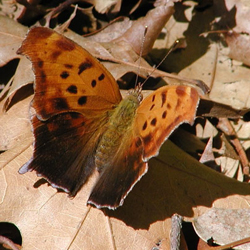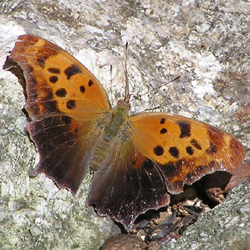Find a Butterfly
Question Mark
Polygonia interrogationis
Named
Fabricius, 1798

Identification
Wingspan: 2 3/8 - 2 5/8". Of the two common and widespread species of anglewings occurring in Massachusetts, this species is readily distinguished from the Eastern Comma (P. comma) by the two parted "question mark" on the hindwing below formed by a silvery, curved bar and separate dot; the Question Mark is also larger and has longer tails than the Eastern Comma. Two distinct seasonal forms of the Question Mark occur. The upper hindwing surfaces of the summer form are largely black. The upper wing surfaces of the winter form are fringed with violet and the hindwings are rich orange above.
Distribution
The range of the Question Mark extends farther south than other North American anglewings and encompasses the region from southeastern Saskatchewan east to the Maritimes and south through Arizona into Mexico, the Gulf Coast, and Florida. This butterfly occurs throughout New England although Scudder (1889) characterized it as being rare in the north.
Status in Massachusetts
The Question Mark is fairly common and widespread throughout much of the state. Typically, one or two Question Marks are found in a given location although small groups are occasionally recorded around a sap flow. Maximum: 10 (at elms along Main Street), Nantucket, 11 August 1988. Scudder (1889) considered this species to be subject to "considerable fluctuations in abundance from year to year . . ." This pattern still holds true: Massachusetts Buterfly Club members recorded zero in 1992 and 175+ in 1994.

Flight Period in Massachusetts
Two generations each year: a summer flight, the so called "umbrosa" form, on the wing between late June and mid to late August and a fall flight, the "fabricii" form, emerging from late August into October. While some individuals of the winter form may overwinter as adults, most apparently migrate south and return in spring (Opler & Krizek 1984, Opler 1992). Extreme dates: 7 April 1987, Warren (Worcester Co.) P. Hostard, and 13 November 1994, Concord (Middlesex Co.) R. Walton.
Larval Food Plants
Hostplants include elms (Ulmus), nettles (Urtica), False Nettle (Boehmeria cylindrica), and hackberry (Celtis). Some authorities also list basswood (Tilia) as a possible hostplant.
Adult Food sources
While this species has been recorded at milkweeds and asters, like other anglewings the Question Mark prefers to visit sap and rotting fruit, and even carrion or scat. This adaptation seems especially well suited to the late summer- overwintering-early spring brood whose nectar sources, at least in the northern part of its range, may be limited.

Habitat
The Question Mark is fond of open woodlots and other semi shaded habitats including forest paths and openings.
Life Cycle
EGG: Green; barrel shaped with nine to eleven prominent vertical ridges. OVIPOSITION: Laid singly or in stacks of five or six on leaves or twigs. LARVA: Variously described as black, brown, or rust colored with several yellow lateral lines, numerous orange branching spines on the body and a pair of black branching spines on the head. CHRYSALIS: A variety of colors including brown, tan, or greenish often with olive spotting; various projections on body and two horn like devices at head. Hangs upside down from twig and often resembles dead leaf. PUPATION: 11-17 days (Harris in Scudder, 1889). OVERWINTERING STAGE: Hibernating adult, mostly further south.
Adults emerge from hibernation in spring and may be seen at sap flows. These are joined by migrants from the south as the season warms. Males often perch and sun on favored tree trunks from which they fly out to inspect passing butterflies and seek receptive females. The dark, summer brood appears as early as late June. The offspring of this generation emerge in late summer and early fall and with the onset of cold weather move south or seek hibernation sites in wood piles and bark crevices.
Account Author
Richard K. Walton



